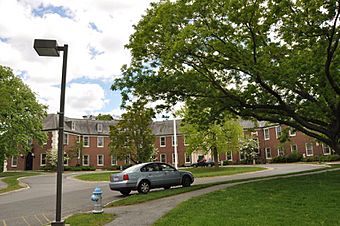Cambridge Home for the Aged and Infirm facts for kids
Quick facts for kids |
|
|
Cambridge Home for the Aged and Infirm
|
|
 |
|
| Location | Cambridge, Massachusetts |
|---|---|
| Area | 2.16 acres (0.87 ha) |
| Built | 1928 |
| Architect | Greco, Charles Reggio; Askin & Sullivan |
| Architectural style | Colonial Revival |
| NRHP reference No. | 02001189 |
| Added to NRHP | October 22, 2002 |
The Cambridge Home for the Aged and Infirm is an old building in Cambridge, Massachusetts. It was built in 1928 by the city. This building was one of the first places built specifically to help older people and those who were very sick. Today, it is called Neville Place. It helps people who need some daily support. The building was designed by Charles Reggio Greco. It was added to the National Register of Historic Places in 2002 because of its history.
About the Building
The Cambridge Home for the Aged and Infirm is located on Concord Avenue. It is near Fresh Pond in the western part of Cambridge.
Its Design
The main building is a large brick structure. It is about two and a half stories tall. The building is shaped a bit like the letter "W". It has a main part in the middle. On each side, there are wings that look like the letter "Y". The building's frame is made of strong concrete. Bricks cover the outside. The main entrance has a special stone design. It has a curved arch and tall columns.
A Place for Care
This home was built in 1928. It took over some services that were once offered at the city's old almshouse. This was the first building in Massachusetts made just for older or sick people. The old almshouse was mainly for people who were poor but healthy. It was not very useful anymore.
Charles Reggio Greco designed this new facility. He was a local architect. He had also designed other buildings for the city. This home was the main place for the city's older and sick people. This lasted until the 1960s when Medicare started. Later, the building became a nursing home. In 1984, it was changed again to be an assisted living facility.
Images for kids




